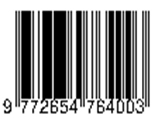DENTIN SEBAGAI BAHAN CANGKOK TULANG DALAM PERAWATAN REGENERASI JARINGAN PERIODONTAL: SEBUAH TINJAUAN
Abstract
Introduction: Alveolar bone is the most affected of the periodontal diseases. Bone grafts such as autograft, allograft, xenograft and, alloplastic often are used, but they have limitations. So, the bone graft is still a major problem that continues to inspire the design of new bone materials. The purpose of this article is to review the clinical and biologic function, advantages, and disadvantages of dentin as an autograft and allograft bone in periodontal therapy. Review: Autograft is still the gold standard in bone augmentation because of its excellent osteoinductivity and osteoconductivity. Bone and dentin are mineralized tissues that have almost similar chemical compositions. Dentin matrix obtained from a tooth has to be demineralized before using it as a bone graft material. Dentin consists of 18% collagen, 2% noncollagenous proteins, 70% hydroxyapatite, and 10% body fluid. Matrix is a repository for growth factors, such as Bone Morphogenetic Proteins (BMP), Transforming Growth Factor-β (TGF-β), Insulin-like Growth Factor (IGF), and Basic Fibroblast Growth Factor (bFGF). Demineralized Dentin Matrix (DDM) is highly biocompatible and can support cell growth and proliferation, enhances the bone remodeling capabilities and autograft leads to the absence of antigenicity. Autograft DDM was further suggested to be an ideal scaffold for stem cells and bone growth factors, therefore autograft tooth could be recycled as the innovative biomaterial. Conclusion: The present results indicate that the autograft dentin materials can be used as a bone graft.
Keywords
Full Text:
PDF (Bahasa Indonesia)References
Kumar, J., Jain, V., Kishore, S. & Pal, H. Journey of Bone Graft Materials in Periodontal Therapy: A Chronological Review. J. Dent. Allied Sci. 5, 30–4 (2016).
Bhattacharjya, C., Gadicherla, S., Kamath, A. T., Smriti, K. & Pentapati, K. C. Tooth Derived Bone Graft Material. World J. Dent.7, 32–35 (2016).
Shidfar, S. H. et al. Autogenous Dentin As a Bone Substitute: a Review. Ann. Dent. Spec.6, 333 (2018).
Bhatt, R. & Rozental, T. Bone Graft Substitutes. Hand Clin. 28, 457–468 (2012).
Kim, Y.-K. et al. Tooth-derived Bone Graft Material. J. Korean Assoc. Oral Maxillofac. Surg. 39, 103–111 (2013).
Murata, M. et al. Human Dentin as Novel Biomaterial for Bone Regeneration. Biomater. - Phys. Chem. (2011) doi:10.5772/25071.
Saima, S., Jan, S., Shah, A., Yousuf, A. & Batra, M. Bone Grafts and Bone Substitutes in Dentistry. J. Oral Res. Rev. 8, 36–8
(2016).
Wang, W. & Yeung, K. W. K. Bone Grafts and Biomaterials Substitutes for Bone Defect Repair: A Review. Bioact. Mater. 2, 224–247 (2017).
Haugen, H. J., Lyngstadaas, S. P., Rossi, F. & Perale, G. Bone Grafts: Which is the Ideal Biomaterial? J. Clin. Periodontol. 46, 92–102 (2019).
Yashavantha Kumar, C., Nalini, K. B., Menon, J., Patro, D. K. & Banerji, B. H. Calcium Sulfate as Bone Graft Substitute in the Treatment of Osseous Bone Defects, A Prospective Study. J. Clin. Diagnostic Res.7, 2926–2928 (2013).
Murata, M. et al. Dentin Materials as Biological Scaffolds for Tissue Engineering. Biomater. Tissue Reconstr. or Regen. (2019) doi:10.5772/intechopen.85452.
Murata, M. et al. Autograft of Dentin Materials for Bone Regeneration. Adv. Biomater. Sci. Biomed. Appl. (2013) doi:10.5772/53665.
Um, I. W., Kim, Y. K. & Mitsugi, M. Demineralized Dentin Matrix Scaffold for Alveolar Bone Engineering. J. Indian Prosthodont. Soc. 17, 120–7 (2017).
Koga, T. et al. Bone Regeneration Using Dentin Matrix Depends on the Degree of Demineralization and Particle Size. PLoS One 11, 1–12 (2016).
Kabir, M. A., Murata, M., Kusano, K., Akazawa, T. & Shibata, T. Autogenous Demineralized Dentin Graft for Third Molar Socket Regeneration - A Case Report. Dentistry 5, 343–7 (2015).
Kim, Y. K., Bang, K. M., Murata, M., Mitsugi, M. & Um, I. W. Retrospective Clinical Study of Allogenic Demineralized Dentin Matrix for Alveolar Bone Repair. J. Hard Tissue Biol. 26, 95–102 (2017)
DOI: https://doi.org/10.33854/jbd.v8i2.895
DOI (PDF (Bahasa Indonesia)): https://doi.org/10.33854/jbd.v8i2.895.g350
Refbacks
- There are currently no refbacks.
Copyright (c) 2021 B-Dent: Jurnal Kedokteran Gigi Universitas Baiturrahmah

This work is licensed under a Creative Commons Attribution-NonCommercial-ShareAlike 4.0 International License.




